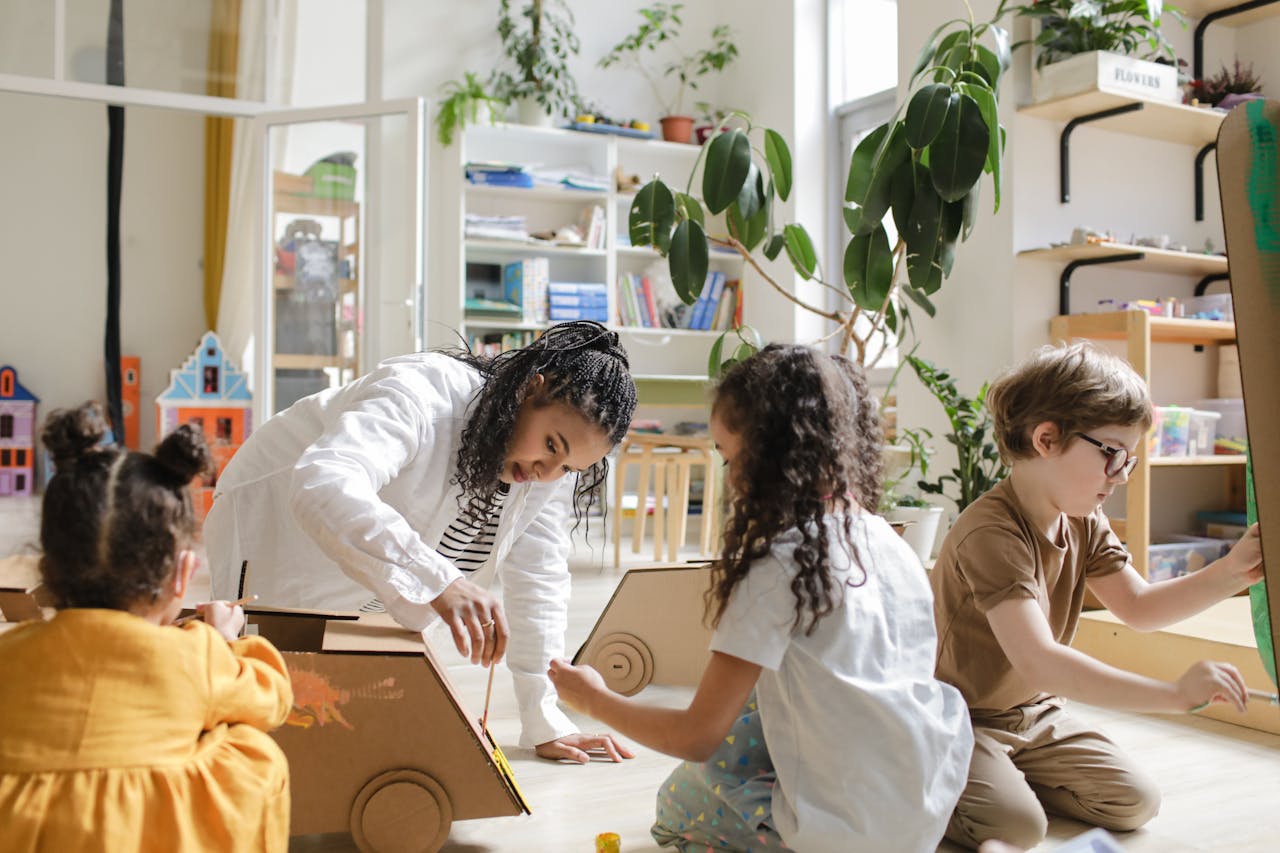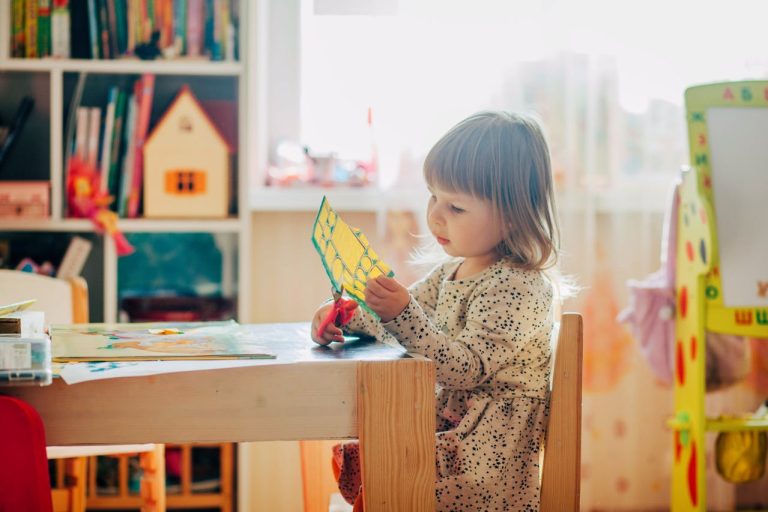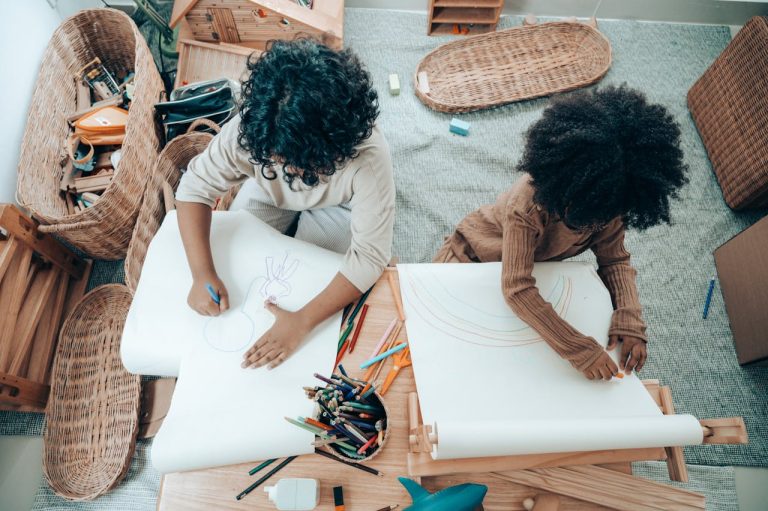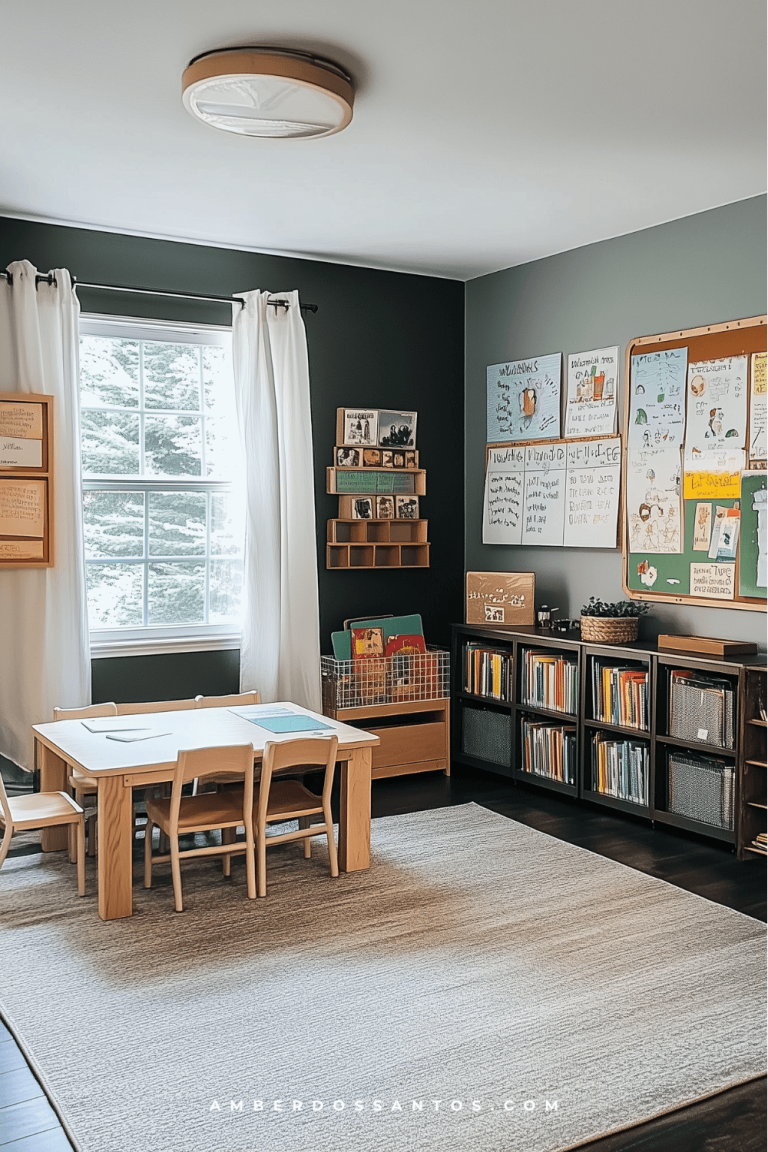5 Proven Tips For a Stress-Free Kindergarten Homeschool Schedule
My first week of homeschooling kindergarten looked exactly as you might expect—I had meticulously organized supplies, detailed schedules, and a homeschool learning space I had agonized over for weeks to perfect. And if I’m being honest, I also had some pretty unrealistic expectations.
Like many new homeschool parents, I found myself deep in Pinterest boards and homeschool blogs, devouring countless books on educational philosophy and homeschooling methods, carefully crafting what I believed would be the perfect kindergarten homeschool schedule.
But by day three, our carefully planned routine had completely fallen apart. My five-year-old was far more interested in our read-aloud time and conversations than in sitting for formal lessons.
I was mentally drained from trying to recreate “school at home” and tired of endlessly piecing together different homeschooling approaches like some impossible puzzle. That’s when it clicked—I was overcomplicating something that should be fundamentally simple.
Through months of adjusting and observing, I discovered these essential truths about kindergarten homeschooling:
- Relationships Come First: Strong parent-child connections create the foundation for natural learning.
- Keep It Simple & Short: Focus on basics (reading, writing, math) in short, focused sessions of 30-90 minutes max per day (10-15min lessons per subject)
- Follow Your Child’s Lead: Understand and work with your child’s unique learning style, using the curriculum as a guide rather than a rigid law.
- Make Learning Come Alive: Spark interest through hands-on projects, storytelling, videos, and outdoor exploration.
- Stay Consistent But Flexible: Build simple routines while remaining willing to adjust when something isn’t working.
Today, I’m sharing my practical approach to creating a kindergarten homeschool schedule that eventually worked for us. Whether you’re just starting out or feeling overwhelmed with your current routine, these suggestions can help you create a schedule that fits your family’s actual life – not an idealized version of it.
Related Read: 7 Reasons Why Homeschool Will Transform Your Child’s Education

Our Simple Kindergarten Homeschool Schedule: A Real-Life Example
Before we discuss the core principles of a kindergarten homeschool schedule, let me share our daily rhythm. This rhythm evolved over time through plenty of trial and error.
It’s not meant to be prescriptive – instead, it’s an example of how simple and flexible a kindergarten day can be while still accomplishing your learning goals.
- 7:30-9:00: Morning routine & Breakfast
- 9:00-9:30: Family table time (bible study, read-aloud, calendar)
- 9:30-10:30: Core learning block (reading/math/writing)
- 10:30-10:45: Movement break/outdoor play
- 10:45-11:45: Hands-on projects/interest-led learning
- 11:45-12:30: Free play/lunch prep
- 12:30-1:30: Lunch and read-aloud
- 1:30-3:00: Quiet time/rest/independent activities
- 3:00+: Family time, errands, activities, free play
Three key things to notice about this schedule:
- Focused Learning Time: We prioritize academic work in the morning when energy and attention are at their peak. This means our most important work gets done when minds are fresh.
- Built-In Flexibility: Notice the generous time blocks and breaks throughout the day. This intentional spacing allows real life to happen – whether that’s a slow morning, an impromptu nature walk, or a doctor’s appointment.
- Natural Learning Flow: Our days aren’t divided into strict academic and non-academic time. Learning happens naturally throughout the day – during meals, errands, play, and everyday moments.
As we explore the following five principles, you’ll understand why these elements matter and how to create a rhythm that works for your unique family situation.

Tip #1: Build Strong Family Connections Through Daily Learning
Do you know what changed everything for my kindergartener’s learning? It wasn’t the perfect curriculum or the most expensive educational toys. It was the simple act of putting connection first.
Our learning space is nothing fancy – just a corner of our living room with a couch and a sturdy wood dining table. But it’s become our special spot for both learning and bonding. We keep our materials organized but accessible, with good lighting and minimal distractions. Sometimes, we’ll play soft music in the background—my kids seem to focus better with gentle tunes.
Simple Ways to Turn Daily Activities into Learning Time
The best learning happens in those everyday moments we might otherwise miss. When we’re cooking breakfast, we count eggs together. During our nature walks, we talk about the changing seasons. These natural conversations become our best teaching tools, way more effective than formal lessons.
Some of our favorite connection times happen during:
- Morning cuddles with books
- Simple art projects side by side
- Outdoor exploration time
- Cooking simple recipes together
- Playing board games
I’ve learned something really important: When my child seems resistant to learning, it’s usually a sign we need more connection time. A quick hug, a funny joke, or five minutes of undivided attention often gets us back on track better than pushing through with lessons.
Remember, your relationship with your child is the foundation for all learning. Keep it simple, stay present, and trust that those small moments of connection add up to something amazing.
Your relationship with your child is your most powerful teaching tool. When learning resistance appears, focus on connection first – a quick hug or five minutes of undivided attention often works better than pushing through lessons.

Tip #2: Focus on Kindergarten Basics: One Small Step at a Time
Teaching kindergarten basics at home works best when we break things into small, manageable pieces. I started by setting aside short periods each day – about 10 to 20 minutes – to focus on one skill at a time. These focused learning blocks prevent overwhelm and make learning enjoyable for both parent and child.
Through trial and error, I’ve found that consistent, brief sessions lead to better understanding than longer lessons. Our simple morning routine with clear goals helps us stay on track with essential skills:
During kindergarten, we focus on:
- Learning all 26 letter sounds (uppercase and lowercase)
- Writing the alphabet (we practice a few letters each week)
- Counting to 100 and writing numbers
- Basic adding and subtraction using objects
- Skip counting by 2s, 5s and 10s
- Developing clear handwriting
- Taking first steps in reading
- Writing personal information like name and address
Sometimes, the hardest part is knowing when to stop. I’ve learned to watch for the wiggling, the loss of focus, or that glazed-over look. That’s when we take learning breaks or switch to something more active. It’s better to end well rather than push through and create frustration.
Related Read: Our Homeschool Kindergarten Curriculum Picks & Worldschooling Plans (2024-2025)
Short, consistent 10-20min learning blocks are more effective than longer sessions. Watch for signs of overwhelm, like wiggling or loss of focus, and end lessons while they’re still engaging rather than pushing through.

Tip #3: Understand Your Child’s Natural Learning Style
One of the greatest gifts of homeschooling is the ability to tailor education to your child’s natural learning style. By observing how your child explores and interacts with the world, you can create learning experiences that truly resonate with them.
I’ve discovered that children often show clear preferences in how they absorb information:
- Visual learners thrive with picture books, educational videos, and demonstrations.
- Auditory learners remember songs easily and learn well through conversations.
- Kinesthetic learners need to touch and move – they understand math better by counting blocks and learn letters by forming them with play dough.
When you notice your child’s natural curiosity emerging – like asking about letters in books or wanting to count objects around the house – that’s your perfect teaching moment.
These organic learning opportunities often lead to the most meaningful discoveries. Don’t be afraid to spend extra time on topics that capture their interest or try different approaches when something isn’t clicking.
Observe how your child naturally explores their world (visual, auditory, or hands-on), then adapt your teaching style to match. The best learning moments often happen when you follow their natural curiosity rather than sticking to a rigid plan.

Tip #4: Incorporate Simple Ways to Make Learning Fun and Active
Making learning engaging doesn’t need fancy materials or complicated plans. In our homeschool, we’ve found that simple activities often create the best learning moments.
By adding movement and hands-on elements to basic skills practice, learning naturally becomes part of our day.
Some of our favorite ways to learn actively:
- Using salt trays for letter practice
- Counting steps as we climb stairs
- Drawing numbers in shaving cream
- Making letter sounds during nature walks
- Building sight words with magnetic letters
- Practicing math with snacks and toys
Storytelling makes abstract concepts more real. When we learn about numbers, we create simple stories about adding and taking away. We make silly sentences using words that start with our focus letter for letter sounds.
Taking learning outside changes everything. We collect leaves for counting, write letters in the dirt, and use sidewalk chalk for word practice. These outdoor education moments often lead to the best questions and discoveries.
Regular skills practice happens naturally when it’s part of play. Whether we’re sorting laundry by color or counting apple slices for snacks, learning fits right into our daily activities.
The most effective learning activities are often the simplest – using everyday objects, movement, and outdoor exploration. Transform regular daily activities into learning opportunities rather than creating elaborate lessons.

Tip #5 Creating Simple Routines That Last
A good homeschool routine feels natural, not forced. Over time, I’ve learned that the best schedules have room to breathe. We keep our daily rhythm predictable enough for security but flexible enough to adjust when needed.
Our basic daily flow looks like this:
- Morning skills practice when minds are fresh
- Active learning through projects mid-morning
- Stories and quiet activities after lunch
- Free play and outdoor time in afternoons
- Simple review before the day’s end
Some signs that tell me our routine needs adjusting:
- Morning tears or resistance
- Frequent unfinished lessons
- Less excitement about learning
- Too many rushed moments
- Skipping important parts of our day
I track progress simply—in a small notebook with daily notes about what we covered and any special moments or breakthroughs. This helps me see patterns in our learning and adjust as needed.
As seasons change, so do our routines. Summer means more outdoor learning, and winter brings more cozy indoor activities. The key is keeping our core learning times steady while letting everything else flow with our family’s natural rhythm.
Build predictable routines to provide security but flexible enough to adapt to real life. Track simple notes about what works and watch for signs that your schedule needs adjusting – like morning tears or frequent unfinished lessons.
Final Thoughts on Creating a Kindergarten Homeschool Schedule Tha Works
Remember, your kindergarten homeschool schedule shouldn’t feel like a burden – it should flow naturally with your family’s rhythm.
The beauty of homeschooling lies in its flexibility to adapt to your unique situation.
Your Getting Started Checklist:
- ✓ Start with connection-building activities
- ✓ Choose 2-3 core subjects to focus on initially
- ✓ Set up a simple learning space with essential materials
- ✓ Plan short 10-15 minute learning blocks
- ✓ Include daily reading time
- ✓ Build in plenty of outdoor time
Signs You’re on the Right Track:
- Your child asks questions and shows curiosity
- Learning feels more natural and less forced
- You’re both enjoying the journey more
- Basic skills are developed through everyday moments
- Your schedule feels sustainable
Whether exploring outdoors, reading together, or working on basic skills, what matters most is creating an environment where learning feels natural and joy-filled. Trust that small, consistent efforts add up to significant progress over time.
Next Steps for Success:
- Choose one tip from this guide to implement tomorrow
- Join a local homeschool group for support
- Start a simple learning journal to track what works
- Review and adjust your schedule monthly
You don’t have to perfect everything at once. Start small, stay flexible, and keep things simple. You’ll be amazed at how much learning happens naturally when you focus on connection first.







